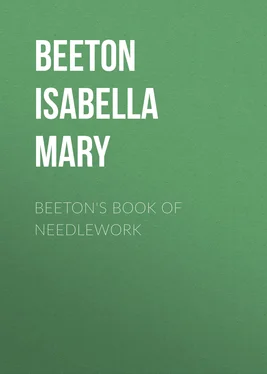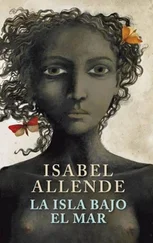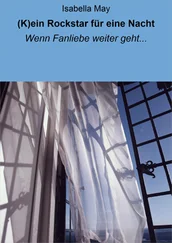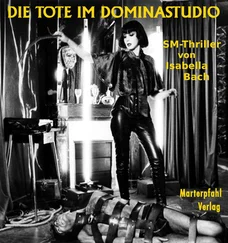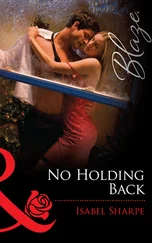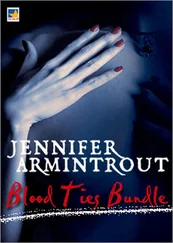Isabella Beeton - Beeton's Book of Needlework
Здесь есть возможность читать онлайн «Isabella Beeton - Beeton's Book of Needlework» — ознакомительный отрывок электронной книги совершенно бесплатно, а после прочтения отрывка купить полную версию. В некоторых случаях можно слушать аудио, скачать через торрент в формате fb2 и присутствует краткое содержание. Издательство: Иностранный паблик, Жанр: foreign_antique, foreign_home, Хобби и ремесла, на английском языке. Описание произведения, (предисловие) а так же отзывы посетителей доступны на портале библиотеки ЛибКат.
- Название:Beeton's Book of Needlework
- Автор:
- Издательство:Иностранный паблик
- Жанр:
- Год:неизвестен
- ISBN:нет данных
- Рейтинг книги:5 / 5. Голосов: 1
-
Избранное:Добавить в избранное
- Отзывы:
-
Ваша оценка:
- 100
- 1
- 2
- 3
- 4
- 5
Beeton's Book of Needlework: краткое содержание, описание и аннотация
Предлагаем к чтению аннотацию, описание, краткое содержание или предисловие (зависит от того, что написал сам автор книги «Beeton's Book of Needlework»). Если вы не нашли необходимую информацию о книге — напишите в комментариях, мы постараемся отыскать её.
Beeton's Book of Needlework — читать онлайн ознакомительный отрывок
Ниже представлен текст книги, разбитый по страницам. Система сохранения места последней прочитанной страницы, позволяет с удобством читать онлайн бесплатно книгу «Beeton's Book of Needlework», без необходимости каждый раз заново искать на чём Вы остановились. Поставьте закладку, и сможете в любой момент перейти на страницу, на которой закончили чтение.
Интервал:
Закладка:
50.– Cravat in Cambric Muslin and Tatting.
Materials: Messrs. Walter Evans and Co.'s tatting cotton No. 100; tatting-pin No. 3.
This cravat consists of a strip of cambric muslin 1 yard long, 6 inches wide, hemmed on both sides. The ends of the cravat are ornamented with patterns in tatting, worked with tatting cotton No. 100. A rosette in tatting is sewn on in the middle of the end of the cravat. The end of the cravat is pointed, lined on the wrong side with a strip of the same material as the cravat, and edged with a tatted lace.
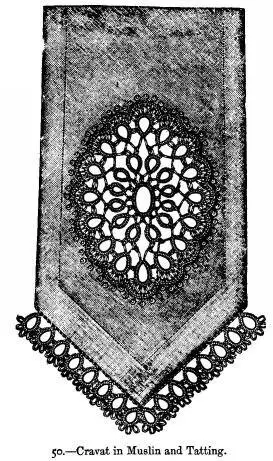
Begin the rosette in the centre with a circle worked in the following manner:–1 double, 1 purl, * twice 2 double divided by 1 purl, 1 purl, 3 double, 1 purl, twice 4 double divided by 1 purl, 1 purl, * 3 double, 1 purl; repeat from * to * once more, 2 double. At the beginning of the 2nd round fasten the cotton on the 1st purl of the 1st round, and work as follows:–* 1 circle consisting of 10 double, 1 purl, 2 double, 1 purl, 10 double; fasten the cotton on to the next purl, 1 circle like the preceding one, fastened on to the next purl, 1 circle consisting of 9 double, 1 purl, 9 double fastened on to the next purl, 2 circles consisting each of 7 double, 1 purl, 7 double; between the 2 fasten the cotton on to the next purl; 2 similar circles fastened also on to the next purl, 1 circle consisting of 8 double, 1 purl, 8 double, fastened on to the next circle; repeat once more from *, and fasten off the cotton. Fasten on the cotton afresh for the 3rd round, worked in the following manner:–* 1 circle consisting of 6 double, 1 purl, 5 double, 1 purl, 6 times 2 double divided by 1 purl; 1 purl, 5 double, 1 purl, 6 double; fasten the cotton at a short distance on to the 1st purl of the 2nd round, 1 circle worked as follows:–5 double fastened on to the last purl of the preceding circle of this round, 4 double, 1 purl, 4 times 2 double divided by 1 purl, 1 purl, 4 double, 1 purl, 5 double fastened on to the next purl of the 2nd circle of the 2nd round; 6 similar circles, between each of which the cotton is to be fastened on to the nearest purl of a circle of the 2nd round; repeat once more from *, and knot the beginning and the end of the cotton together. When completed, the rosette is sewn on the material of the cravat with button-hole stitches, taking up one purl with each stitch; the muslin is cut away underneath the rosette; then work a round of knotted stitches underneath the button-hole stitch. For the lace, make a row of circles one-fifth of an inch distant from each other, consisting each of 6 double, 1 purl, 2 double, 1 purl, 4 times 2 double divided by 1 purl, 1 purl, 2 double, 1 purl, 6 double, which are fastened together by the purl of each circle, and are sewn on the cravat over the cotton between the circles in overcast stitch.
51– Cravat in Cambric Muslin and Tatting .
Materials: Messrs. Walter Evans and Co.'s tatting cotton No. 100; tatting-pin No. 3.

The end of this cravat is formed by a long rosette or médaillon in tatting. This rosette is likewise begun in the centre, and consists of 4 rounds, the 2 first of which are worked like those of the rosette in illustration 50, with this difference only, that in the 2nd round each of the circles nearest to the top and to the bottom of the rosette consists of 8 double, 1 purl, 2 double, 1 purl, 8 double. 3rd round: * 1 circle, consisting of 6 double, 1 purl, 5 double, 1 purl, 6 times 2 double divided by 1 purl, 1 purl, 5 double, 1 purl, 6 double, fastened on to the next purl of the 2nd circle of the preceding round; 1 circle as follows:–5 double, the last of which is fastened on to the last purl of the preceding round, 4 double, 1 purl, twice 2 double divided by 1 purl, 1 purl, 4 double, 1 purl, 5 double fastened on the next purl of the preceding round; 8 more similar circles, between each of which the cotton is fastened on to the next purl of the preceding round; repeat from * once more, fasten the two ends of the cotton together. 4th round: * Fasten on the cotton afresh with a circle consisting of 7 double, 1 purl, 4 double, 1 purl, 6 times 2 double divided by 1 purl, 1 purl, 4 double, 1 purl, 7 double, fastened on to the middle purl of the 1st circle of the preceding round; a 2nd circle worked in the same way, only instead of working the last purl, fasten the cotton on to the last purl of the preceding circle, then on to the 1st circle of the preceding round; 10 more similar circles, between each of which the cotton is fastened on to the middle purl of a circle of the preceding round, and then on to the 2nd purl of the larger circle at the bottom of the medallion; repeat once more from *. The pattern is sewn on the cravat with button-hole stitches, as can be seen in the illustration.
52.– Border in Crochet and Tatting .
Materials: Messrs. Walter Evans and Co.'s Boar's Head cotton No. 26.
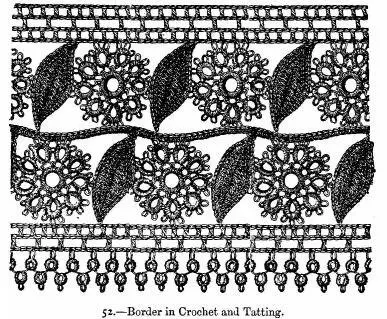
This border is formed of circles in tatting and crochet leaves, which are joined together by rows of crochet work; a narrow border in tatting forms the lower edge. Omitting this edge, the border forms a strip of insertion. Each of the rosettes or circles is begun in the centre; work first 2 double (a double stitch is formed by passing the thread over the back of the hand, and then passing the shuttle upwards between the forefinger and second finger, and drawing it up, then work a stitch of plain tatting; this completes the double stitch, and whenever so many double stitches are directed it means the 2 stitches), 1 purl, repeat 9 times, join the stitch into a circle, work at a small distance * a smaller ring consisting of 3 double, 5 purl, divided each by 2 double stitches, 4 double, draw the cotton through the purl of the first circle, and repeat 8 times more from *, only each following circle must be fastened on to a purl of the preceding circle after 3 double stitches, and having completed each circle the thread must be drawn through the purl of the first circle, which forms the centre of the rosette. The beginning and the end of the thread are knotted together. For the tatted border, make at short distances 1 loop with 5 double, 1 purl, 5 double; after having worked a sufficient number of such loops, wind another thread round the thread between the loops, turning always 1 loop on the right side and 1 on the left. Now begin the crochet part with the leaves. Make for each of these a foundation chain of 12 stitches, crochet back over this chain 2 double in the last stitch but one, 1 double in the next stitch, 1 treble in each of the following 7 chain, 2 treble in the next stitch, 2 treble, 1 long treble, and 2 treble in the next following stitch of the foundation chain. Work on the other side of the chain the same pattern, only the reverse way; then 3 double in the point of the leaf thus formed, and edge the whole leaf with a round of double stitches, always working 2 double in each stitch of the preceding row, and 3 in the long treble stitch. In working this last round, the circles must be joined to the leaves by taking up the purl stitch of the circle before casting off the corresponding double stitch of the leaf; then work the stem which joins the 2 rows of circles and leaves with a row of chain stitches, on which a row of double is worked. Then comes the border which forms the upper edge. Make a row of chain stitches, joining leaves and circles together, then work 3 rows of treble, work 3 more rows over the tatted border, the first row entirely in chain stitches, after every fourth stitch take up the purl of the loops on one side. 2nd row: 1 treble in the middle stitch of the 3 chain, 2 treble, divided by 3 chain. 3rd row: 1 treble, 1 chain, miss 1 under the last. In the last row the leaves and circles must be fastened on the border, as seen in illustration.
Читать дальшеИнтервал:
Закладка:
Похожие книги на «Beeton's Book of Needlework»
Представляем Вашему вниманию похожие книги на «Beeton's Book of Needlework» списком для выбора. Мы отобрали схожую по названию и смыслу литературу в надежде предоставить читателям больше вариантов отыскать новые, интересные, ещё непрочитанные произведения.
Обсуждение, отзывы о книге «Beeton's Book of Needlework» и просто собственные мнения читателей. Оставьте ваши комментарии, напишите, что Вы думаете о произведении, его смысле или главных героях. Укажите что конкретно понравилось, а что нет, и почему Вы так считаете.
